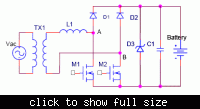samson.bunty1986
Member level 5
Hi all,
Here am attaching the datasheet of Batttery charger..Kindly go through it and explain me how they form boost circuit??and how they calculated the duty cycles?? If i would like to get 30V output to charge 24V,45AH battery how to calculate the duty cycle?? The mains waveform Has Positive and negative half cycles so how they calculated the Inductor value,duty cycle,charging current??they are saying that this circuit will form boost circuit in +ve and -Ve half cycle...In this circuit how to control the current?? I would like to have 7A charging current at initial.
One more thing,as we know the mains voltage has positive and negative pulses..so how to take instant voltages here to operate mosfets?? Since,here each mosfet will work in each cycle..
So kindly help me out to understad this circuit...
Thanks in advance
Here am attaching the datasheet of Batttery charger..Kindly go through it and explain me how they form boost circuit??and how they calculated the duty cycles?? If i would like to get 30V output to charge 24V,45AH battery how to calculate the duty cycle?? The mains waveform Has Positive and negative half cycles so how they calculated the Inductor value,duty cycle,charging current??they are saying that this circuit will form boost circuit in +ve and -Ve half cycle...In this circuit how to control the current?? I would like to have 7A charging current at initial.
One more thing,as we know the mains voltage has positive and negative pulses..so how to take instant voltages here to operate mosfets?? Since,here each mosfet will work in each cycle..
So kindly help me out to understad this circuit...
Thanks in advance
